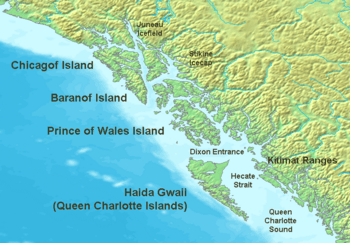Baranof Island facts for kids
|
Native name:
Sheet’-ká X'áat'l
|
|
|---|---|

Islands of the Pacific Northwest Coast
|
|
|
Location in Alaska
|
|
| Geography | |
| Location | ABC islands of Alaska |
| Coordinates | 56°57′05″N 134°56′52″W / 56.95139°N 134.94778°W |
| Archipelago | Alexander Archipelago |
| Area | 1,607 sq mi (4,160 km2) |
| Length | 100 mi (200 km) |
| Width | 30 mi (50 km) |
| Highest elevation | 5,390 ft (1,643 m) |
| Administration | |
|
United States
|
|
| State | Alaska |
| Demographics | |
| Population | 8532 (2000) |
| Pop. density | 2.05 /km2 (5.31 /sq mi) |
Baranof Island, also sometimes called Baranov Island, Shee or Sitka Island (Russian: остров Баранова, Ситха; also остров Ситка) is an island in the northern Alexander Archipelago in the Alaska Panhandle, in Alaska. The name Baranof was given in 1805 by Imperial Russian Navy captain U. F. Lisianski to honor Alexander Andreyevich Baranov. It was called Sheet’-ká X'áat'l (often expressed simply as "Shee") by the native Tlingit people. It is the smallest of the ABC islands of Alaska.
Geography
The island has a land area of 1,607 square miles (4,162 square kilometres), which is slightly larger than the state of Rhode Island. It measures 105 miles (169 km) by 30 miles (48 km) at its longest point and perpendicular widest point, respectively. It has a shoreline of 617 miles (993 kilometres). Baranof Island hosts Peak 5390, the highest mountain in the Alexander Archipelago, and is the eighth largest island in Alaska, the tenth largest island in the United States, and the 137th largest island in the world. Its center is near 57°0′N 135°0′W / 57.000°N 135.000°W. Most of the island lies within the limits of Tongass National Forest. A large part has been officially designated as the South Baranof Wilderness. A little bay called Ommaney Bay is located in the south end of the island. the escort carrier USS Ommaney Bay (CVE-79) bears its name.
Communities
The population of the island was 8,532 at the 2000 census.
Almost the entire area of the island is part of the City and Borough of Sitka (Sitka also extends northward onto Chichagof Island). The only part of Baranof that is not in Sitka is a tiny sliver of land (9.75 km²) at the extreme southeast corner, which is in the Petersburg Borough, and includes the town of Port Alexander. This section had a 2000 census population of 81 persons. The towns of Baranof Warm Springs, Port Armstrong, and Port Walter are also located on the eastern side of the island. Goddard, a now-abandoned settlement about 16 miles (26 kilometres) south of Sitka, features a few private homes and hot springs with two public bathhouses. There are also five year-round salmon hatcheries, one located just north of Port Alexander at Port Armstrong, another located just north of Baranof Warm Springs at Hidden Falls, two are located in the city of Sitka one at the Sitka Sound Science Center, and another in the Sawmill Cove Business Park; the other just south of Sitka near Medvejie Lake. The latter is accessible by private road from Sitka. All of these communities, except for Port Alexander and Port Armstrong, are under the jurisdiction of the City and Borough of Sitka, of which, Sitka serves as the borough seat.
Fishing, seafood processing, and tourism are important industries on the island, which is also famous for brown bears and Sitka deer.
Social and economic history
The first European settlement on the island was established in 1799 by Alexander Baranov, the chief manager and first governor of the Russian-American Company for whom the island and Archipelago are named. The island was the center of Russian activity in North America during the period from 1804 to 1867 and was the headquarters of the Russian fur-trading interest.
Around 1900, Baranof Island was subject to many small-scale mining ventures, especially centered on Sitka and on the north side of the island around Rodman Bay. Canneries, whaling stations, and fox farms were established on Baranof Island and smaller islands around it, though most had been abandoned by the beginning of World War II. The remains of these outposts are still evident, though most exist in a dilapidated condition.
In February 1924 the Alaska Territorial Game Commission hired Charlie Raatakainen to transplant mainland goats from near Juneau to Bear Mountain. Raatakainen hired a group of Finns aboard his boat the Pelican to complete the job, though one of the group died in the process.
The 1939 Slattery Report on Alaskan development identified the island as one of the areas where new settlements would be established through immigration. This plan was never implemented.
Fictional accounts
Louis L'Amour's novel Sitka describes the conflict between the Russian fur trading empire and yankee settlers.
The island features prominently in James A. Michener's multigenerational novel Alaska.
The Yiddish Policemen's Union is a 2007 alternate-history novel by Michael Chabon about a Jewish Yiddish-speaking territory in Sitka, including most of Baranof Island. The novel proceeds from the counter-factual premise that the Slattery Report had actually been implemented.
Local author John Straley has written a number of mystery novels set on and around Baranof Island.
The Sea Runners, a 1982 novel by Ivan Doig.
See also
 In Spanish: Isla de Baranof para niños
In Spanish: Isla de Baranof para niños


